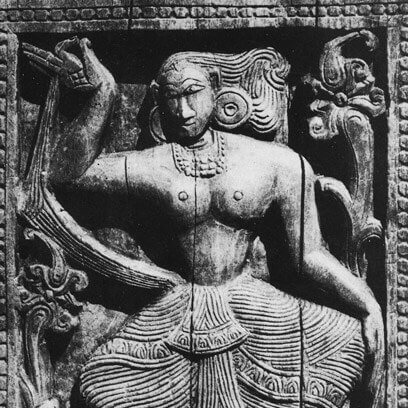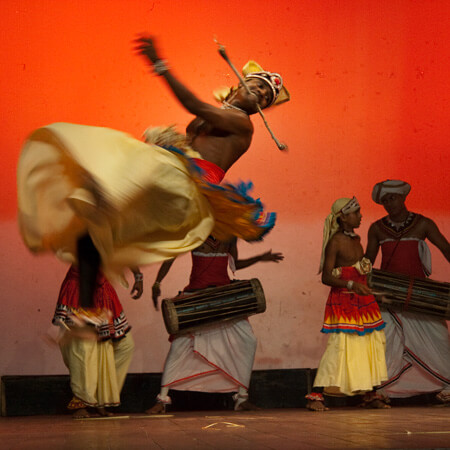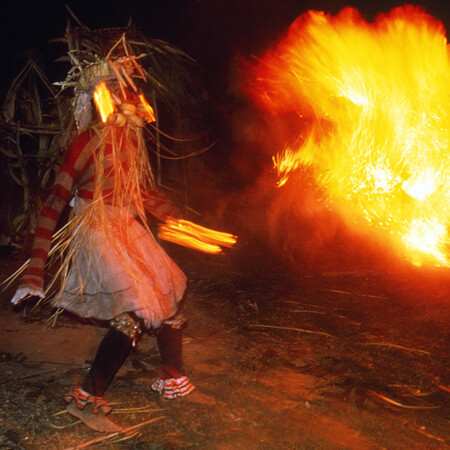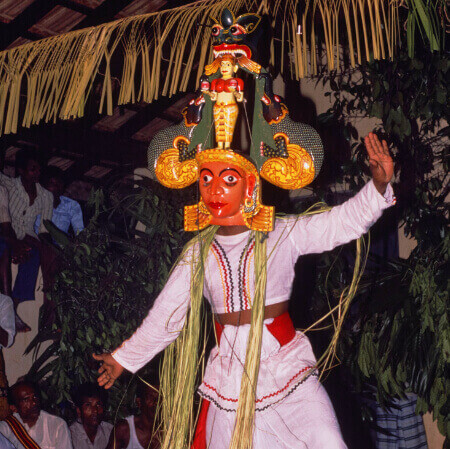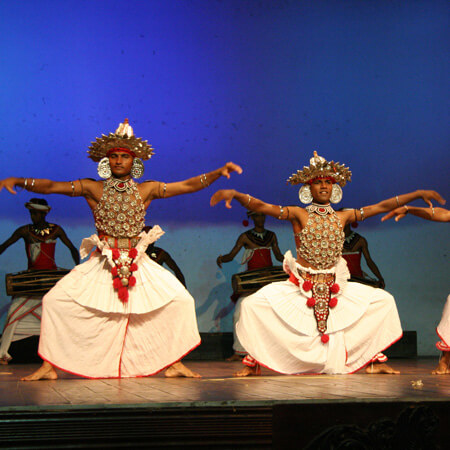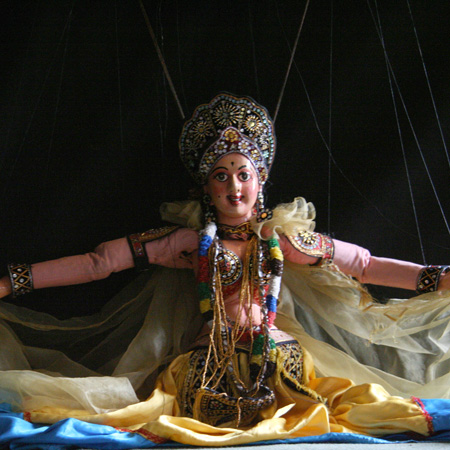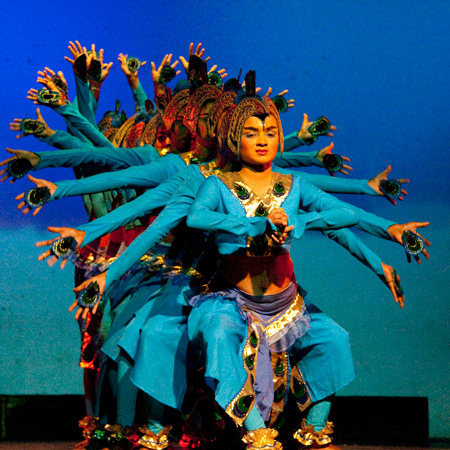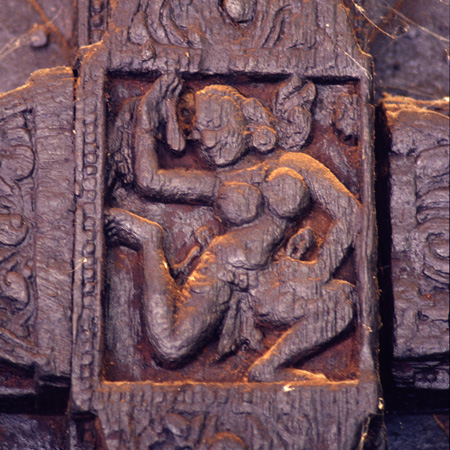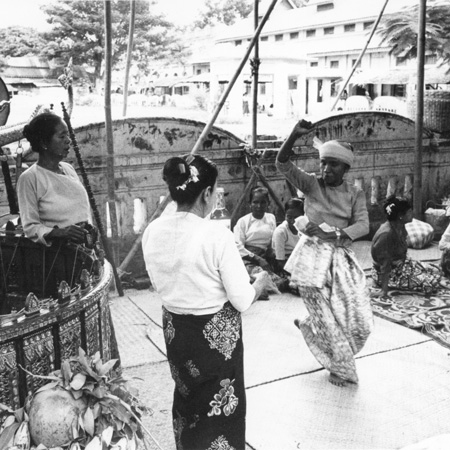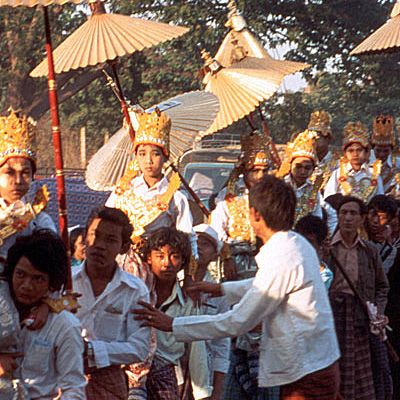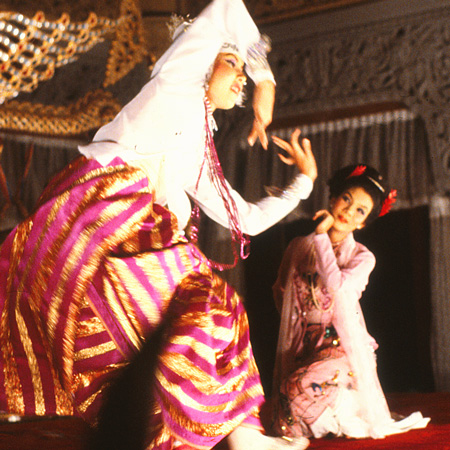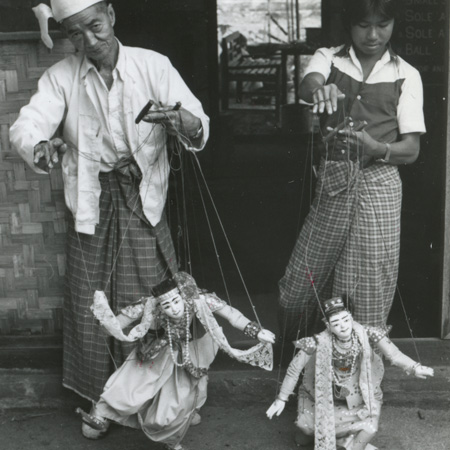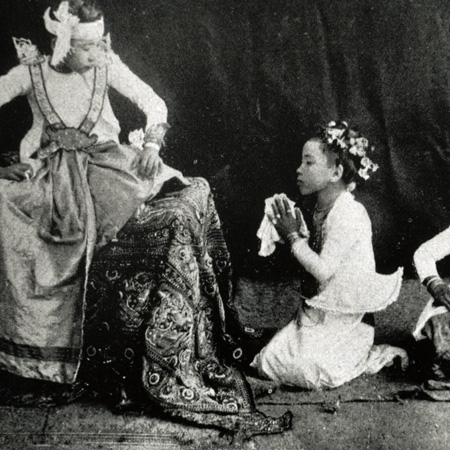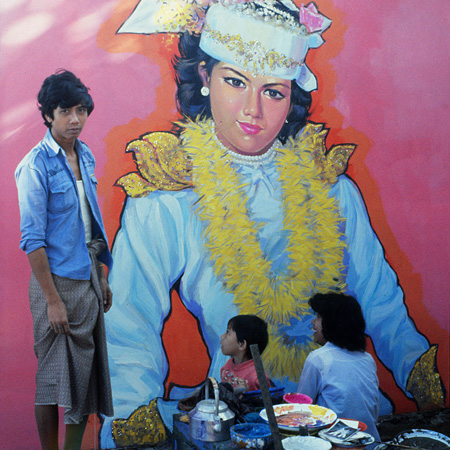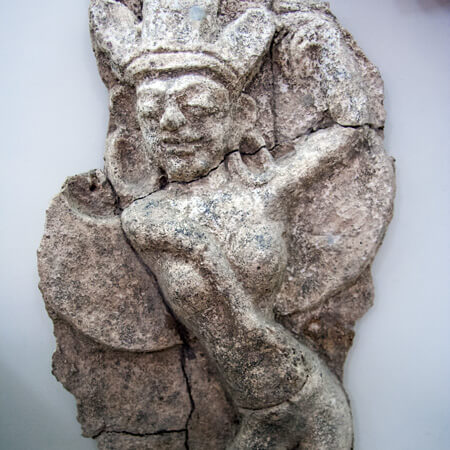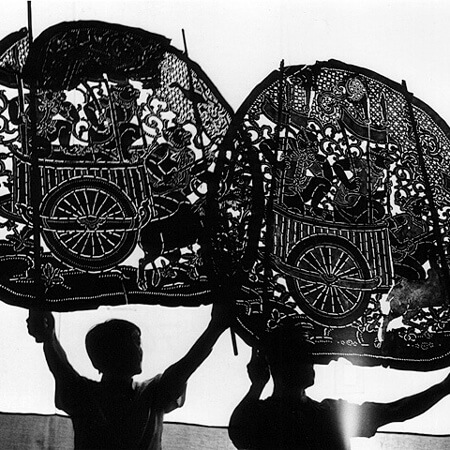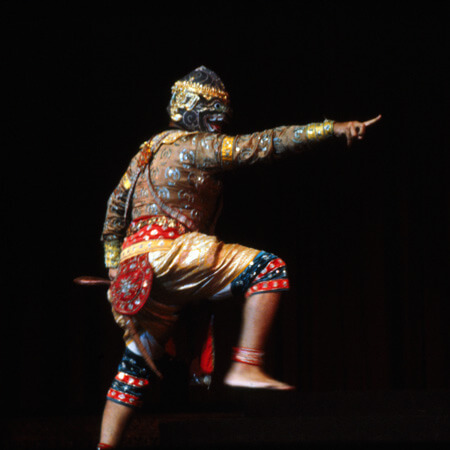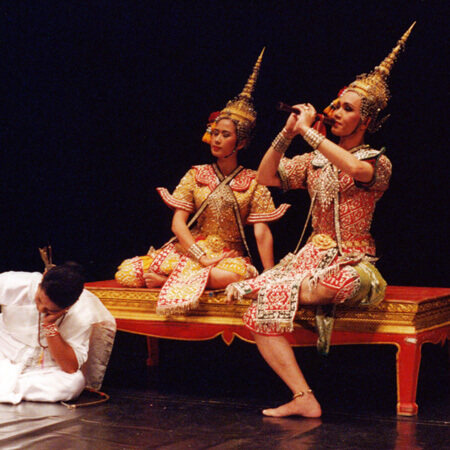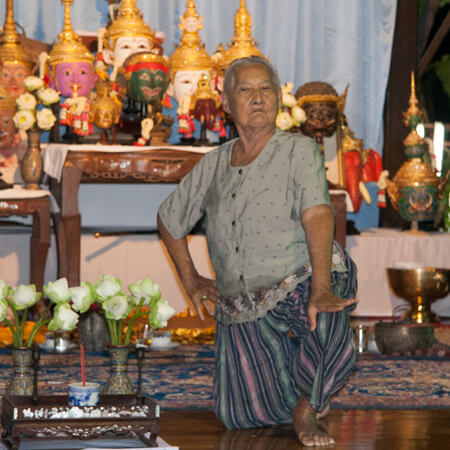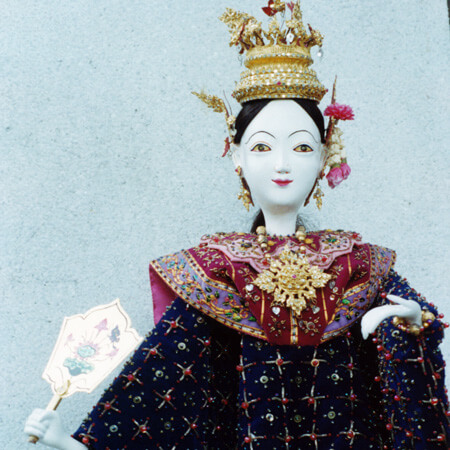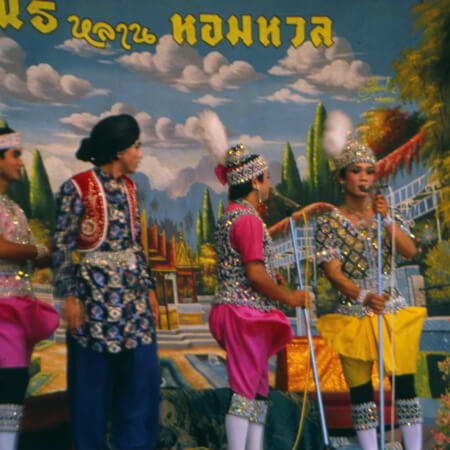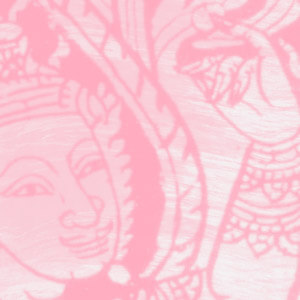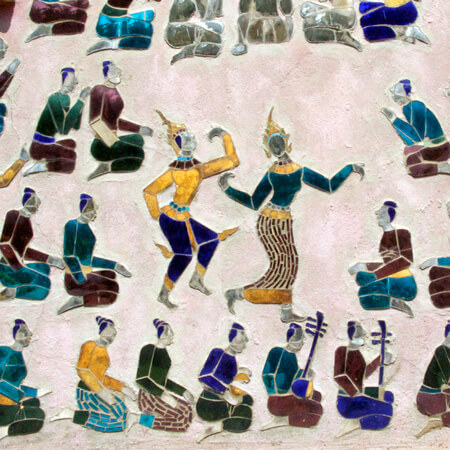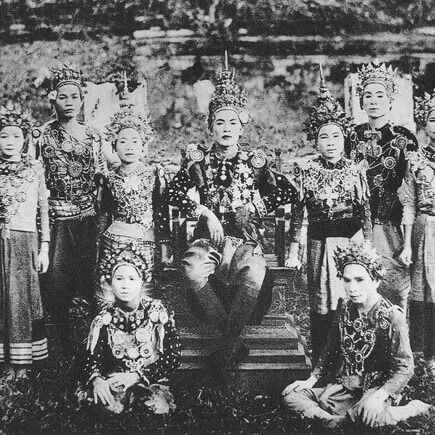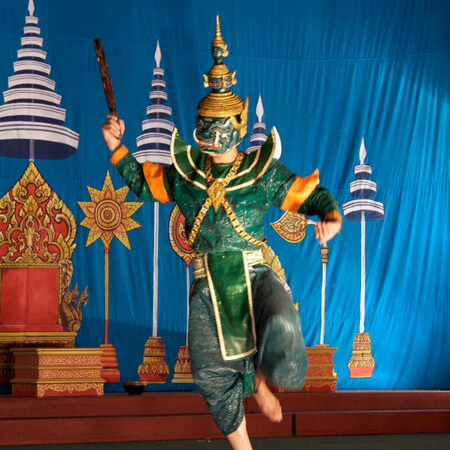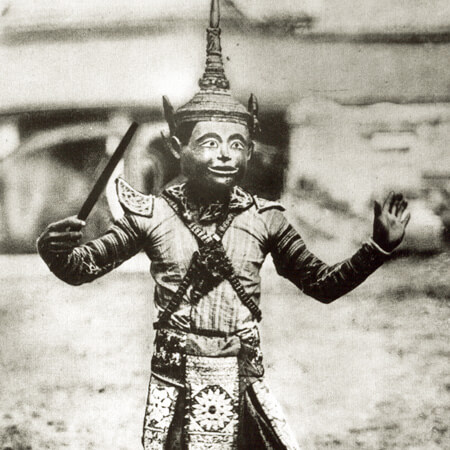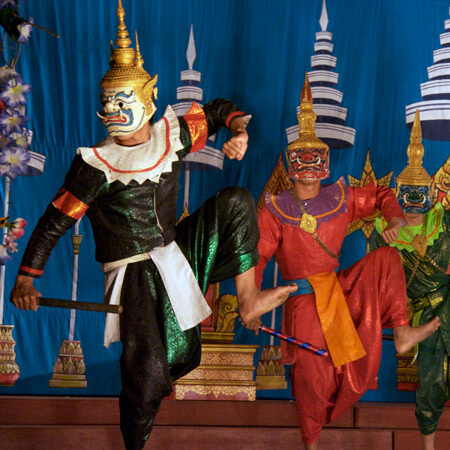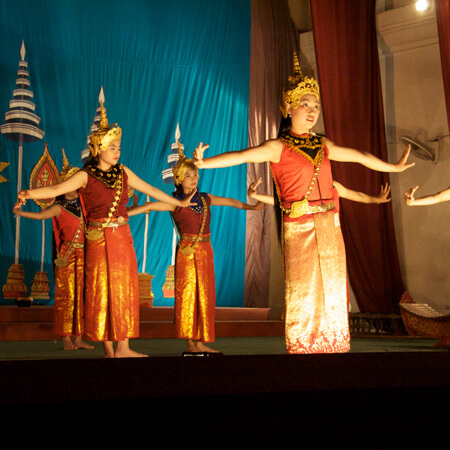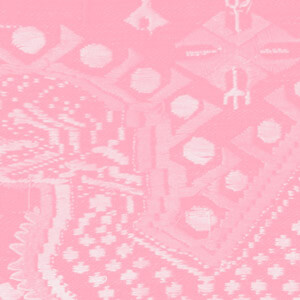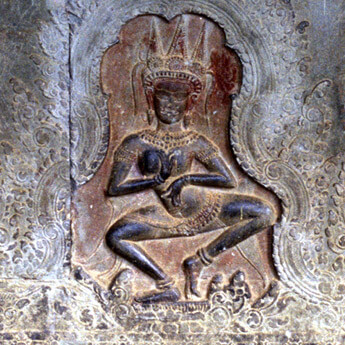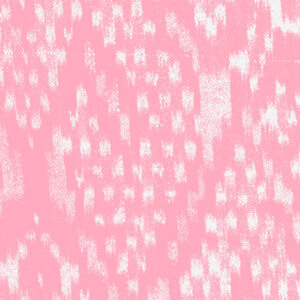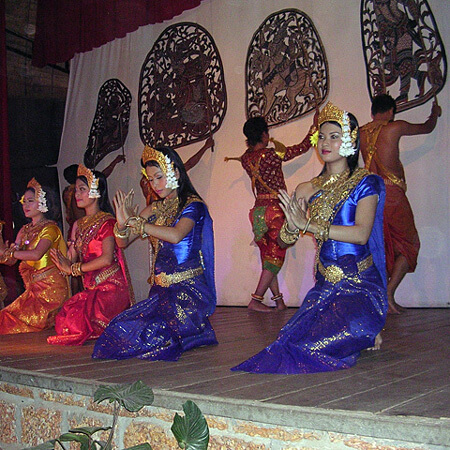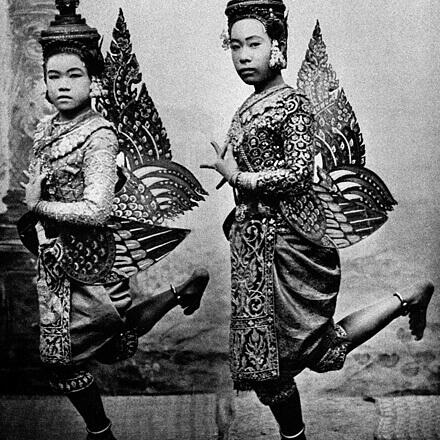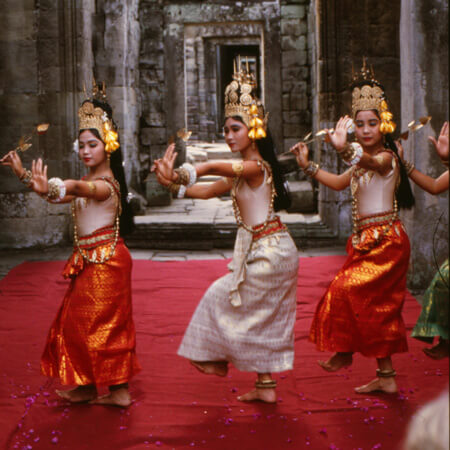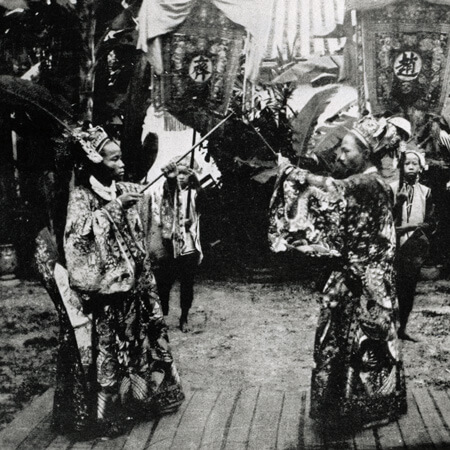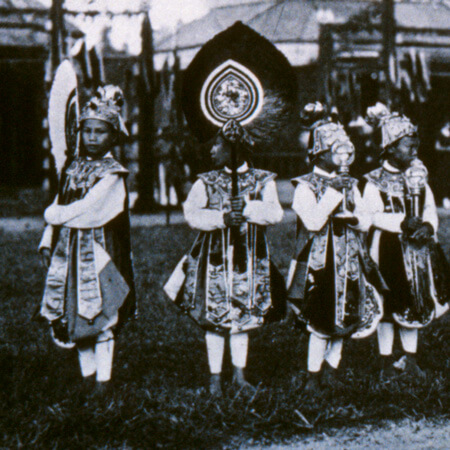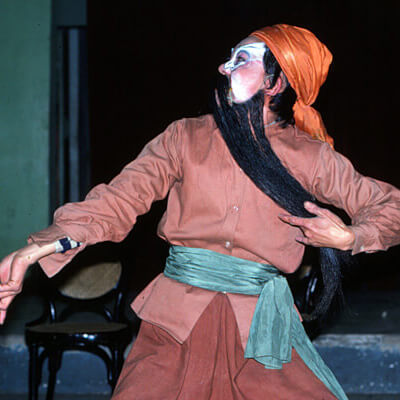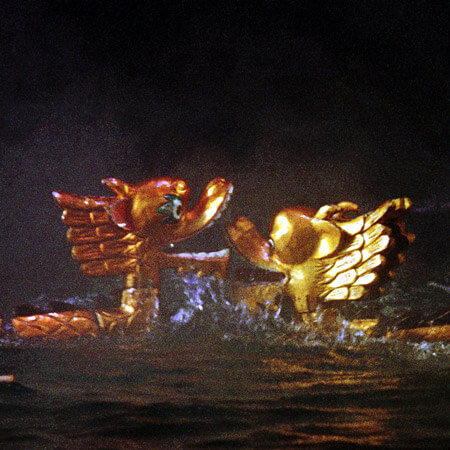As is often the case in Asia, the early existing textual and visual sources concerning theatre and dance in Sri Lanka also mainly deal with the traditions, which were related to the upper classes of society. The writing of inscriptions and chronicles, as well as the carving of stone reliefs, were done mainly by order […]
Present Traditions
Sri Lanka has several still extant traditions of dance and theatre. The most archaic of them are some of the folk rituals, particularly exorcism ceremonies, that aim to propitiate various evil spirits. These forms include, among others, tovil and sanni. Characteristic of most of the folk rituals is the use of colourful masks. Sanni, for […]
Mask Performances, the Yaktovil and the Sanni Yakuma
by Wolfgang Mey The south-west coast region of Sri Lanka is known for its elaborate mask dances. Healing rituals (Yaktovil) like the Sanni Yakuma have been used to treat people made ill by malevolent supernatural beings (yakku). Also, a form of masked dance theatre called Kolam is still sometimes performed. In these traditions actors wear […]
The Kolam, a Folk Drama
by Wolfgang Mey The Kolam, or Kolam Dances are a folk drama that was developed by the members of the fisher community on the south-west coast of Sri Lanka over several centuries. It is still but rarely performed today. In the past the performances were spread over up to seven nights, in the late 20th […]
The Kandyan Dances
Video clip: Ves performance Veli Rosenberg The Kandyan, or up-country (udarata natum), dances, are regarded as the classical dance tradition of Sri Lanka. Kandyan dancers are traditionally performed only by male dancers. The technique, partly derived from South India, focuses on dynamism, powerful footwork, leaps and whirls. It has a vast repertoire, partly originating from […]
Rukada, the Marionette Theatre
Sri Lanka has its own form of marionette theatre and its puppets are called rukada or “miniature figures”. Like all marionettes, rukadas are also operated from above by means of strings. The golden age of the marionette theatre was in the late 19th century and the early 20th century. Nowadays only a few groups perform […]
The Twentieth Century
Regardless of Sri Lanka’s political turmoil and continuous civil war, some forms of performing arts are widely practised even today. The gradual secularisation of Kandyan dances, first when they were added to the annual Kandy Perahera procession in 1916, and later in the 1950s when they were, in standardised form, added to the curricula of […]
Facts about Myanmar (formerly Burma)
Myanmar (formerly Burma) is an isolated country, both geographically and politically. It is separated from its neighbours to the west, north, and east by mountains and is bordered by the Indian Ocean in the south. Until the late 18th century it expanded politically, but the 19th and 20th centuries have been a period of deliberate […]
Early Traditions
The Burmese are believed to have arrived in their present territory in the 9th century AD. The former inhabitants of the country were the Khmer-related Mons, and the Pyus, whose kingdoms flourished in the Irrawaddy River basin from the early centuries AD to the 9th century. When one considers how little is known about the […]
Nat Pwe, Spirit Rituals
As in many Southeast Asian cultures, so too in Myanmar an ancient animistic belief system exists side by side with the official main religion, in this case Theravada Buddhism. Spirits are called nat in Myanmar, and the nat spirits were already canonised very early on. There are altogether 37 nat. They may be the spirits […]
Nibhatkin and the Ordination of the Monks
In older times a form of Buddhist processional theatre, called nibhatkin, was popular in Myanmar, but now it seems to have more or less disappeared and given way to more recent theatrical traditions. It was a kind of mystery play, in which tableaux depicting the life of the Buddha and his earlier incarnations were taken […]
Burmese Dance
There is only fragmentary knowledge of the early history of Myanmar classical dance. It seems clear, however, that the present style and technique evolved over some 1 500 years, incorporating elements of the earlier Mon and Puy traditions predating the arrival of the Burmese. As may be expected, Indian influences are clearly present, but it […]
Yokhte Pwe, Burmese Marionette Theatre
Burmese literary sources mention that marionette theatre was known in the country as early as the 15th century. However, it is generally believed that Burma’s highly valued marionette theatre tradition (yokhte pwe) was formulated at the beginning of the so-called golden age of Burmese theatre in the late 19th century. Its original purpose was to […]
Zat Pwe, The Burmese Dance-Drama
Zat pwe is the classical form of dance-drama in Myanmar. It often includes sung passages as well. The Buddhist Jataka stories or their adaptations form the most popular literary material for these dramas, hence the name “zat”, which indicates a Jataka. Stories are, however, also derived from Burmese history. Traditionally, these kinds of plays, accompanied […]
The Twentieth Century
In the early 19th century the British first gained control of Southern Burma, converting Rangoon (Yangon) into a Western-style colonial centre. In 1866 they finally extended their dominion to Upper Burma. Partly because of the uncompromising attitude of Thibaw, the last king of Burma, the British used violent means to gain power. The court was […]
Facts about Thailand
Thailand is a melting pot of Southeast Asian culture. The influence of Chinese and Indian civilization has been felt in the area of present-day Thailand for over two millennia, and the Malay Peninsula provided access to the cultural sphere of Malaya and Indonesia. The Tai-speaking people are believed to have moved gradually into their present […]
Early Periods
The Sukhothai Period (1240–1438) According to the traditional rendering of Thai or Siamese history, the first independent Tai Kingdom was Sukhothai (1240–1438). During this period the Tais created their own art style, which was eclectic at the beginning, combining elements from the Mons, Khmers, and the Srivijaya maritime empire in the south, and from Sri […]
Nang Yai, Theatre of the Large Shadow Figures
Nang yai (“large puppet”) is an ancient form of shadow theatre in which dancing puppeteers perform scenes from the Ramakien by presenting cut-out leather figures against a semi-transparent cloth screen. In the latter part of the 20th century it became very rare but attempts have recently been made to revive it. The Question of its […]
Thai Classical Dance
The present Thai classical dance (natasin) probably developed during the Ayutthaya period (1350–1767), although very little is known about the process. Its roots can be deciphered by using the early dance images of the region, already discussed above, as archaeological source material. The possible origins of Thai dance may be found in the Khmer tradition […]
Khon, “The Masked Pantomime”
Khon is one of the most spectacular forms of Southeast Asian dance-drama. It can involve over a hundred actors, a large piphad orchestra, narrators, singers, and a chorus. Khon is often described as ’masked pantomime’. This is an apt term, for the khon actors do not speak their lines. They only enact their characters on […]
Lakhon, Forms of Dance-Drama
Lakhon is an overall term referring to many forms of dance-drama in Thailand. It may derive from Java, where the plot of a performance is called lakon. The most archaic genre of lakhon is lakhon nora or nora from the Thai part of the Malay Peninsula, which will be discussed later. The most classical form […]
The Wai Kru Ceremony
In Thailand, as in many other Asian countries, the arts of dancing and acting are regarded as a kind of spiritual activity. Pupils studying and performing khon and lahkon dance-dramas are expected to show deep gratitude to their teachers or gurus, who through successive generations give them an opportunity to learn the art of dance […]
Nora, Archaic Dance-Drama
Nora is a form of dance-drama performed mainly in the southernmost provinces of Thailand and the northern parts of Malaysia. The name nora is a shortened form of the name Manora, the standard heroine of an ancient tale, which often serves as the plot material for this type of dance-drama. The genre is also known […]
Forms of Puppet Theatre, Nang Talung and Variants of Hun
Along with the ancient nang yai shadow theatre, already described earlier, Thailand is the home of two other forms of puppet theatre, the southern nang talung shadow theatre and the three-dimensional puppet theatre hun, with its several sub-categories. In these forms of drama the repertoire is mostly derived from the Ramakien. However, nang talung and […]
Likay “Folk Operetta”
Likay may still be the most popular form of folk theatre in Thailand. It is performed on temporary stages at temple fairs and at other communal festivities as well as on permanent stages. The sets consist of garishly painted backdrops portraying, for example, palace halls, gardens, or forests. The costumes are a blend of different […]
The Twentieth Century
During the reign of reformist rulers at the end of the 19th century, traditional Thai theatre came up against competition from spoken drama and even Western opera. Admiration of Western art introduced realism and naturalism, undermining even more the role of traditional stylised Thai theatre, especially as Western-type stages, illusionistic sets, and lighting effects were […]
Facts about Laos
The mountainous, landlocked region of present-day Laos was inhabited by the end of the first millennium AD by the Lao people, who belong to the Tai language group. They are believed to have migrated from southern China. In fact, Laos forms an ethnic mosaic with its numerous highland groups. Each of them has their own […]
A Stormy History
The regions of present-day Laos were politically united by the Kingdom of Lan Xang (also Lane Xang) for the first time in 1353, when Fa Ngum was crowned its king and Luang Prabang became its capital. Lan Xang was, however, surrounded by mightier neighbours, such as the Khmers, Chinese, Vietnamese, Siamese (Thai), and the Burmese. […]
Mohlam, Hypnotic Storytelling
Laos received most of its court-related “classical” theatre traditions from its more powerful neighbours, first from the Khmers and later from the Thais. One indigenous feature is a reed organ called khen, the national instrument of Laos, which is used to accompany a type of troubadour singing. This style is known as mohlam, and it […]
Phra Lak Phra Lam, The Localised Ramayana
Like its Theravada Buddhist neighbours, Thailand, Myanmar, and Cambodia, Laos also has its own version of the originally Indian epic Ramayana. In fact, there exist two versions of it, Khvay Thurapi and the better-known Phra Lak Phra Lam. The title of the latter combines the names of the two epic heroes, Laksmana (Pha Lak) and […]
Phra Lak Phra Lam as a Court Dance-Drama
The Lao court at Luang Prabang is believed to have adopted its classical court culture from the Khmers in the mid-fourteenth century. The small court was probably unable to afford large choruses of dancers, and the Khmer tradition was accordingly adapted to a smaller scale. Increasing Thai hegemony spread the Thai dance and drama tradition […]
The Royal Ballet Theatre
Until 1975, when the Lao People’s Republic was founded, the Phra Lak Phra Lam was performed regularly at the court of Luang Prabang. The communist regime abolished the royal rituals and dance, and theatre training was carried on by the Natasin School of Music and Dance (University of Fine Arts) in Vientiane. Annual performances were, […]
Dance
The dance techniques of the demon and monkey characters generally follow the style of Thai khon. The technique of the noble male and female characters is more relaxed compared with khon. Finger movements are not so backward bent as in khon and, as a whole, the dance seems to be based on ram wong, a […]
Puppet Theatre
Laos also has a tradition of puppetry reflecting the influences from Thailand. A royal rod puppet theatre, lakhon tukata, is, in many respects, similar to the Thai hun krabok theatre. Its repertoire mainly consists of scenes from the Phra Lak Phra Lam. The tradition was broken but has now been revived by the Ee Pawk […]
Facts about Cambodia
The roots of Cambodian dance and theatre are believed to lie in ancient indigenous rituals, such as funerary ceremonies or rites connected to animistic or ancestor worship. Most of these predate the emergence of Funan (C.AD 100–550) and Chenla (550–800), the first Indian-influenced kingdoms, or power centres, in the regions of today’s Cambodia. Early documentary […]
Dance and Theatre in the Civilization of Angkor
Indian influence started to spread to the region at the latest during the early centuries AD, when two kingdoms or chains of chiefdoms, Funan (c. 150–550) and Chenla (c. 550–800), flourished in the Mekong Delta area. The Khmer empire of ancient Cambodia flourished from the 9th to the 15th centuries. Even from the beginning of […]
After Angkor
The heyday of Khmer culture came to an end in 1431, when the Thais conquered Angkor and the Khmer court for the second time, and also, possibly, its artists were captured and taken to the Thai capital of Ayutthaya. The conquerors greatly valued the dance and theatre traditions as well as other aspects of the […]
Archaic Ceremonial Performances
In the countryside and in the villages of Cambodia there have existed and still exist several types of ceremonial performance, which clearly have their roots in local animistic traditions. Among them are several possession traditions with shamanistic features. Possession or trance can be an integral element even in a ritual performance related to the classical […]
Shadow Theatre, Sbek Thom and Sbek Touch
Sbek thom (large leathers) is an ancient form of shadow theatre in which dancing puppeteers perform scenes from the Reamker, or more rarely the Buddhist Jataka stories, by presenting cut-out hide figures against a semi-transparent cloth screen. It is an exceptional and clearly very archaic form of shadow theatre. Its only “sister” form is the […]
Classical Dance
Several types of dance exist in Cambodia. Pure dance is often referred to as robam, ancient dance as robam moram, dance-dramas as lakhon and the classical dance of today as lakhon kbach boran. The best preserved and most well known of them in the West is the classical tradition, which has been closely connected to […]
Lakhon Khol
The Cambodian lakhon khol (also lakhon khaol or lakhon bhani) is clearly a sister form of Thailand’s khon mask-theatre. They both illustrate mainly the localised versions of the Indian epic Ramayana, which is known in Cambodia as the Reamker and in Thailand as the Ramakien. They are both regarded as national epics in their respective […]
Lakhon Bassac
The classical traditions of Cambodia are, to a great extent, an integral part of the Indian-influenced court culture of South-East Asia. On the other hand, lakhon bassac, the popular theatre of Cambodia, bears strong Vietnamese and Chinese influences as a result of the close contacts between Cambodia and southern Vietnam during the period of French […]
The Twentieth Century
Despite the great Royal Dance Troupe’s success at the Marseilles Colonial Exhibition in 1906, dance and dance-drama declined in the early 20th century. A revival started during the 1940s. Prince Sihanouk (later King, Prime Minister, and the Head of State) employed the royal dancers as cultural ambassadors during his visits abroad as well as during […]
Facts about Vietnam
Vietnam is the only Southeast-Asian country where the Chinese influence has predominated in theatre and dance, and culture in general, for centuries. This is the result of various historical and geographical factors. Geographically, Vietnam belongs to both East and South-East Asia. The Indo-Chinese Peninsula, of which Vietnam occupies a narrow stretch in its eastern half, […]
Earliest Sources
Dong Son Gongs: Earliest Visual Sources Before the period of direct Chinese influence, North Vietnam was the home of a Bronze Age culture called Dong Son. The best-known artefacts created in this culture are large bronze “kettle drums” or gongs, in which dancers and processional performances are also depicted. Together with some cave paintings they […]
The Legacy of Hué
In the historical context outlined above, it is only natural that Chinese influence has been prominent in Vietnamese theatrical traditions since the times of the Indian-influenced Champa kingdoms. According to oral tradition, a Vietnamese ruler of the early eleventh century employed a Chinese actor to teach his court actors the art of “Chinese satirical theatre”. […]
Hat Boi, Court Opera
The Chinese opera style was thus adopted by the Vietnamese at an early stage. Vietnamese court opera is called hat boi (hat: to sing; boi: gesture, pose), which developed into its classical form in the fourteenth century. Outwardly, it resembles Chinese opera to a great degree. As in Chinese opera, the hat boi actors sing […]
Ceremonial Dances
Along with hat boi, the court also developed ceremonial dances imitating the practice of the Chinese imperial court. In other parts of Southeast Asia the poses and hand gestures of almost all the main forms of court dance reflect a more or less direct Indian influence, whereas Vietnamese court dances, in their slow ceremoniality, echo […]
Hat Cheo, Popular Cheo Opera
Hat cheo or cheo opera is a form of popular musical theatre accompanied originally by a small orchestra consisting of a fiddle, a flute, and a drum. In recent decades the size of the orchestra has grown greatly. The music is indigenous North Vietnamese and it is constructed from well-known stock melodies such as heart-breaking […]
Mua Roi, A Unique Form of Water Puppetry
Vietnam also has its own tradition of puppet theatre, mua roi nuroc (puppets that dance on water). It is an old and rare North Vietnamese form of puppet theatre, and it has actively been revived since the 1980s. In a number of small villages near Hanoi water puppet theatre is still performed at certain festivities, […]
